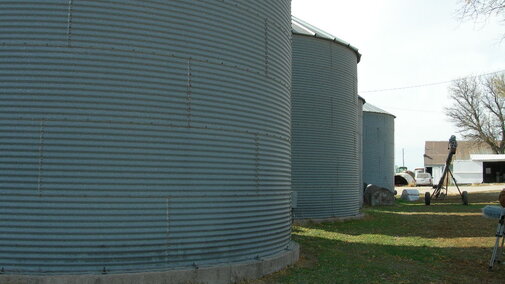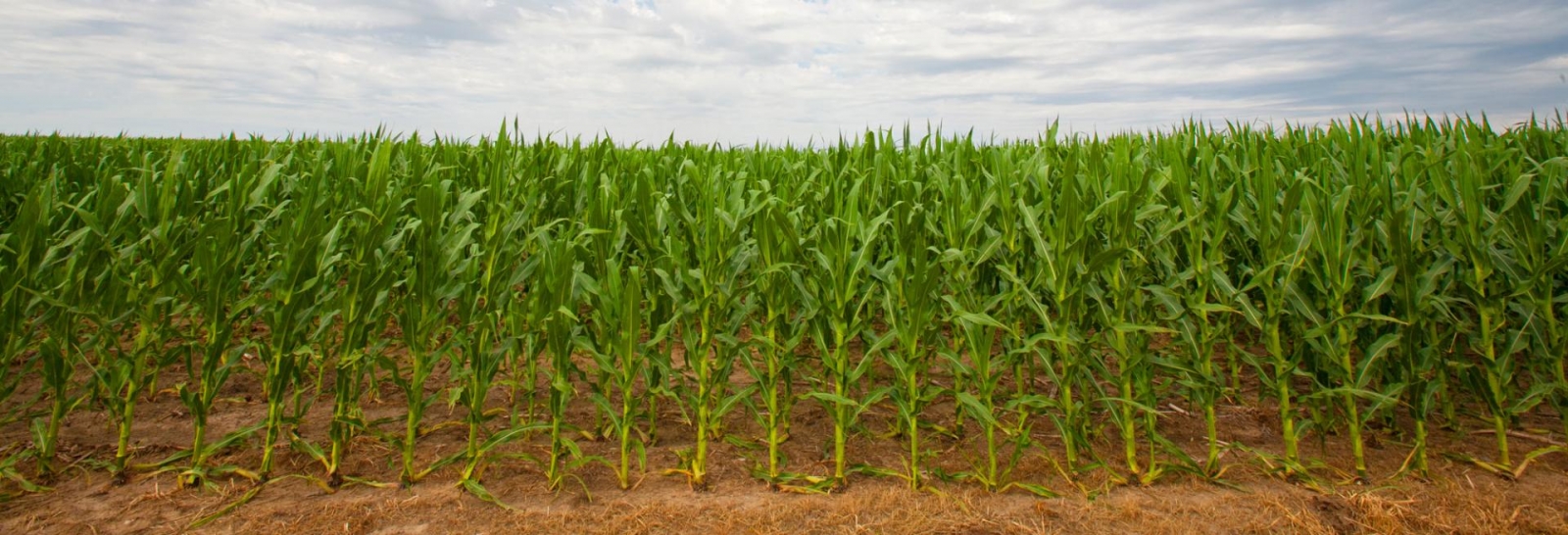Energy savings for drying grain in layers:
0.29-2.5 cents/bushel/point of moisture removed
More articles in this series
Article reviewed and updated by Chuck Burr, Nebraska Extension Educator
Many grain producers have on-farm grain drying and storage facilities. Most have more than one bin equipped with a high capacity aeration fan (over 1 cfm/bu of capacity) and many have the ability to add supplemental heat to the air before it is passed through the grain to reduce drying time.
The time required to dry grain is a function of the amount of moisture that must be removed from the grain to bring it down to the desired moisture content, the rate of airflow through the grain (cubic feet per minute per bushel, cfm/bu), and the properties of the incoming air (temperature and relative humidity). The airflow a fan can push through the grain is a result of the interaction of the fan performance curve (cfm vs static pressure) and the airflow resistance curve (static pressure vs grain depth).
| Grain Depth (feet) |
Bushels (in bin) |
Airflow (cfm)1 |
Airflow (cfm/bu) |
Static Pressure (inches H2O) |
Horsepower Required for Fan Operation |
|---|---|---|---|---|---|
| 18 | 8,245 | 9,194 | 1.12 | 3.65 | 8.9 |
| 13.5 | 6,183 | 10,551 | 1.71 | 3.34 | 9.29 |
| 9 | 4,122 | 11,997 | 2.91 | 2.69 | 8.45 |
| 4.5 | 2,061 | 13,265 | 6.44 | 1.56 | 5.43 |
1Airflow values generated by the FANS computer program available for free download from the University of Minnesota Post Harvest Handling of Crops Web site at http://bbe.umn.edu/postharvest Fan model: Caldwell F24-10, 10.5 hp axial flow fan. Bin: 27 ft diameter with a full mesh drying floor |
|||||
| When bin is filled on Day 1 | When bin is filled and dried in layers | |||||
|---|---|---|---|---|---|---|
| Scenario | Hours to dry | Electricity for fan (kWh) | Propane2 for added heat (gal) |
Hours to dry | Electricity for fan (kWh) |
Propane for added heat (gal) |
| Natural Air | 350 | 3675 | 0 | 221 | 2317 | 0 |
| Heated to 80°F | 156 | 1638 | 347 | 113 | 1191 | 313 |
| Heated to 95°F | 106 | 1113 | 430 | 79 | 840 | 400 |
| Heated to 110°F | 85 | 898 | 466 | 65 | 688 | 440 |
1The simulation assumed a stirring device was used when adding heat to the incoming air to prevent over-drying the grain on the bottom of the bin and the heated air, accounting for the cfm output and time required for drying for each grain depth scenario. |
||||||
A mathematical analysis was run to study the advantage of filling drying bins in layers as an alternative to the normal practice of filling one bin completely before filling the next bin. Four scenarios were evaluated under each system. Scenarios included:
- using natural air (assumed to be 60°F and 50% relative humidity),
- heating the ambient air to 80°F,
- heating it to 95°F, and
- heating it to 110°F.
For the analysis, harvest was assumed to begin when the corn in the field reached 20% moisture content. In the simulation where the bin was filled the first day, the entire grain mass in the bin was assumed to be 20% moisture. For the scenarios where the bin was filled in layers, one-quarter of the bin capacity was assumed to be added at a time. The next layer would be added as soon as sufficient time had elapsed for the air passing through the grain to carry away the excess moisture in the preceding layer. The moisture content of the standing corn in the field was assumed to drop one-quarter percentage point per day while waiting for the corn added in the preceding layer in the bin to reach 15.5% moisture.
Table 1 shows the expected airflow (cfm and cfm/bu) for the specified fan model when the specified bin (1) is filled in four equal layers. The 18-foot grain depth shows the performance for the entire drying time when the bin is filled on day 1 as well as the performance after the fourth layer of grain was added when layer drying.
This simulation computed the time to remove the excess moisture each time new grain was added to the bin (full bin or each individual layer). The electricity for fan operation was computed based on the horsepower requirement (Table 1) and the hours of operation to remove the excess moisture. The propane consumption was based on the BTUs needed to change the enthalpy of the ambient air to the specified temperature, accounting for the specific volume of air passing through the grain in each scenario. The target average moisture content was 15.5% in all scenarios. The results of the simulations are summarized in Table 2.
| Scenario | Time to dry full bin (hrs) | Time to dry Layers (hrs) | Time saved by drying in layers (hr) | Time saved by drying in layers | Energy cost to dry Full Bin* | Energy cost to dry Layers* | Energy cost saved for layer drying vs filling the bin on day 1 | Energy cost saved for layer drying vs filling the bin on day 1 |
|---|---|---|---|---|---|---|---|---|
| Natural AIR | 350 | 221 | 129 | 36.9 | $294 | $185 | $109 | 37% |
| 80°F | 156 | 113 | 43 | 27.6 | $825 | $720 | $105 | 13% |
| 95°F | 106 | 79 | 27 | 25.5 | $948 | $867 | $81 | 9% |
| 110°F | 85 | 65 | 20 | 23.5 | $1003 | $935 | $68 | 7% |
* Electrical energy cost assumed to be $0.08/kW-hr and propane cost assumed to be $2.00/gal |
||||||||
The time-to-dry and electrical energy advantage when drying in layers comes from the reduction in static pressure when pushing air through shallower grain depths. The lower the static pressure the higher the airflow (cfm) the fan can produce. There are fewer bushels in the bin when it is partially filled. So reducing grain depth results in greater cfm through fewer bushels which results in higher rates of airflow per bushel (cfm/bu) when drying the first three layers as opposed to filling the entire bin on day 1. Horsepower peaks for this particular fan model and bin scenario at 13.5 feet of grain depth, and then drops back slightly when the bin is full (Table 1). Filling in layers therefore reduces drying time because of greater average airflow and reduced costs because of lower average electrical consumption per hour.
Comparisons can be made between various scenarios using Tables 3 and 4. Note there is a 5.4-fold increase in energy cost per point of moisture removed per bushel when comparing the least cost scenario and the highest cost scenario in Table 4 (0.504 vs 2.714). Comparing drying time between these same two scenarios (Table 3) shows the least expensive drying method resulted in a 2.6-fold increase in drying time (221 vs 85 hours) compared to the most expensive method. It is worth noting, the percentage increase in energy expense was more than twice the magnitude of the percentage decrease in drying time.
| AIR TEMPERATURE | FILLED ON DAY 1 |
FILLED IN LAYERS |
ENERGY COST SAVED FOR LAYER DRYING VS FILLING ON DAY 1 |
|---|---|---|---|
| NATURAL AIR, 60°F | 0.794 | 0.504 | 0.294 |
| 80°F | 2.224 | 1.944 | 0.284 |
| 95°F | 2.564 | 2.344 | 0.224 |
| 110°F | 2.714 | 2.524 | 0.194 |

